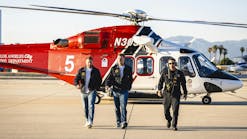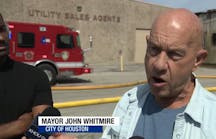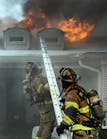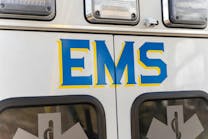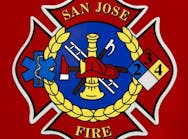Calabasas/Malibu Fire
Oct. 21-28, 1996
Origin: Eastbound 101 Freeway between Parkway Calabasas and Las Virgenes Road
Cause: Downed power line
Acres: 14,950
Structures lost: Six homes, two mobile homes, three vehicles.
Firefighters: 4,049
Injuries: 16, including a Long Beach firefighter who suffered a broken neck in an apparatus collision and six firefighters seriously burned when overrun by fire
Equipment & crews: 92 strike teams, 155 hand crews, 162 agencies, two Canadair SuperScooper aircraft., two Erickson Sky Crane helitankers, six fixed-wing tanker aircraft plus lead aircraft, six water-dropping helicopters
Residents evacuated: 1,000 plus
Once again, as in years past, flames roared down upon the city of Malibu, CA, as a wind-driven wildfire swept through the Malibu Canyon from the San Fernando Valley to the coast in just a few hours.
Santa Ana Winds in excess of 50 mph were blasting through Southern California on the morning of Oct. 21, 1996. The humidity was at a 15-year low of 5 percent. A devastating fire was already destroying homes in the Lemon Heights area of Orange County when the Los Angeles County Fire Department (LACoFD) received a report of a brushfire along Parkway Calabasas near the 101 freeway just after 10:30 A.M. A power line had been felled by the wind and ignited the tinder-dry brush below.
Pushed by the strong winds, the fire quickly grew in size and in minutes over 30 acres had been burned. At the outset, the fire was being blown in a northerly direction toward Las Virgenes Road. But a sudden shift in wind sent flames racing toward the Stokes Canyon area where dozens of homes were located. Strike teams were sent into the narrow canyon to protect homes and Los Angeles County sheriff's deputies began evacuating residents well ahead of the fire's arrival.
Photo by Ken Koller Strike teams speed down the Pacific Coast Highway near Pepperdine University late in the afternoon of Oct. 21.
In minutes, the firestorm exploded through Stokes Canyon, sending residents who had ignored evacuation orders scrambling to escape. Both sides of the canyon were instantly engulfed in flames, and fire crews did all they could to protect themselves as well as the homes at which they were positioned.
As the fire raced across Mulholland Highway, a call was put out for 30 strike teams, literally hundreds of engines, to be sent to Malibu and take up defensive positions in the projected path of the fire. At this point, it was determined that there was going to be no stopping the fire until it reached the Pacific Ocean and that the main focus of firefighting operations would be protecting homes and structures in the fire's path. Residents of Malibu, who have lived though fires of this magnitude every few years, had already begun packing pets and valuables into their cars, preparing for an evacuation hours before the fire reached the coast. Experience told them that the fire was heading their way and nothing was going to stop it from reaching their homes.
Photo by Gene Blevins/CFPA Los Angeles County camp crew firefighters try to control the fire along 101 Freeway.
As flames were knocking on Malibu's back door, another flank of the fire was burning well to the southeast of the main fire, threatening not only homes in the Monte Nido area but LACoFD Station 67 as well. Residents were quickly evacuating their homes with their horses in tow as fire crews made their way into the heavily wooded area.
A massive deployment of fire resources averted a major loss of homes in the area, as the fire blew through and burned along the south face of Malibu Canyon in nearly the same path as the devastating 1993 blaze (see "Firestorm '93," March and July 1994).
As the fire crested the hill in Malibu, students at Pepperdine University were evacuated from classrooms and dormitories and sheltered in the gymnasium at the center of the campus. The university's fire brigade supplemented the dozens of fire crews that had been sent to encircle the campus. The fire brigade used its mini-pumper to douse small spots of flames well inside the grounds of the campus while students braved the swirling ash and burning embers to stand outside and watch the fire bear down on their school.
Photo by Gene Blevins/CFPA A Los Angeles County air ship makes a drop along the 101 Freeway in the early stages of the fire.
Nightfall brought no relief from the "Devil Winds," as flames continued to pound away at firefighters attempting to at least slow the blaze. Flames were burning on both sides of the Pacific Coast Highway, threatening the exclusive Malibu Colony and the homes of such celebrities as Pierce Brosnan and Jane Seymour.
Many of the residents who were evacuated from their homes had to be evacuated again later in the evening, as flames licked at the outskirts of the Michael Landon Community Center, where the Red Cross had set up a shelter. Darkness halted the use of fixed-wing aircraft but LACoFD and Los Angeles City Fire Department (LAFD) helicopters continued to make drop after drop well into the early-morning hours.
Overnight, the first serious injury occurred when a Long Beach engine lost its brakes and slammed into a civilian's car. A captain riding in the engine suffered a broken neck and was airlifted to a hospital.
As morning broke, the high winds of the previous day had subsided somewhat, although the humidity was not much higher than it had been the day before. Daylight allowed a massive attack by fixed-wing aircraft in Corral Canyon, the last active area of fire. All morning long, two SuperScooper aircraft on lease to Los Angeles County from Quebec hammered away at hot spots as air tankers laid down a line of retardant on the outskirts of the burn area. Dozens of engines stood ready in front of homes as firefighters watched the morning air show in the canyon below.
At the staging area at the Malibu Civic Center, hundreds of pieces of fire apparatus from throughout California awaited assignment to the fire lines. The temperature began a steady rise as the day wore on. In Corral Canyon, a sudden flare-up sent pillars of thick smoke hundreds of feet into the air. Then the unthinkable happened. In a matter of moments, flames exploded up the side of the canyon, overrunning two Glendale firefighters who had been trying to protect a home on Newell Road. Firefighters Scott French and Bill Jensen were badly burned Jensen critically with third-degree burns over 70 percent of his body.
Just a few hundred yards away, LAFD Strike Team 1001 was trying to make its way down narrow Newell Road when Engine 10 was overrun by flames, trapping the four firefighters inside. Two of the four were seriously burned; the others escaped with only minor burns. The injured firefighters were airlifted to the Grossman Burn Center in Los Angeles.
Two days after the fire began, crews began to get a break from the wind. Forecasts called for even stronger winds in the later part of the week, so firefighters worked feverishly to stamp out hot spots. An infrared camera was flown over the area to find hidden fires. The next few days consisted of the backbreaking chore of cutting a line by hand completely around the fire. The orange suits of inmate hand crews dotted the hillsides as they worked to encircle the fire. A large number of strike teams were kept in the staging area as a precaution not only in the event of a flare-up in Malibu but an outbreak of another serious fire in Southern California when the Santa Ana Winds returned that weekend. (The tactic paid off when a fire pushed by 60-mph winds broke out Friday in Ventura, 50 miles north of Malibu. When the Ventura County Fire Department asked for 10 strike teams, they were sent from the Malibu fire and arrived in Ventura only an hour later.)
In all, only six homes were lost to the flames, compared to the 326 lost in 1993. The massive response of equipment coupled with homeowners properly clearing brush around their homes and replacing flammable roofs with fire-resistant materials were credited with averting a replay of the Old Topanga Fire disaster three years earlier.
Captain Jensen's Homecoming
The cool breeze that buffeted Corral Canyon the morning of Oct. 22, 1996, was in no way a reminder of the wrath of nature that drove a massive wildfire from Calabasas to Malibu less than 24 hours earlier.
Photo by Ken Koller Glendale Fire Captain Bill Jensen receives the Medal of Valor from Burbank Fire Chief Richard Hinz.
On Newell Road near the top of Corral Canyon, the engines of Strike Team 1202A dotted the landscape, each taking up a position at one of the handful of homes along the narrow and windy street.
Captain Bill Jensen and his crew from Glendale Fire Department Company Engine 24 were assigned to the first home on Newell Road, their lime-green engine parked out front. The serenity of the morning was disrupted by the occasional hum of airtankers hitting small hot spots across the canyon. Except for the light smoky haze that hung in the air, it was the quintessential Malibu morning.
That night, Bill Jensen was fighting for his life, nearly his entire body ravaged by severe burns. His prognosis for survival was dismal.
Three and a half months later, Bill Jensen walked out of the Grossman Burn Center at Sherman Oaks Hospital.
Jensen and his crew were overrun by flames as the fire unexpectedly flared up and caught them before they had a chance to escape. Along with four Los Angeles City firefighters who were also overrun by the fire just a few hundred yards away, Jensen and Glendale Firefighter Scott French were airlifted to UCLA Medical Center. Jensen, French and LAFD Firefighter Ross Torstenbo were soon transferred to the Grossman Burn Center.
When Jensen arrived at the burn center, his chances for survival were put at only 5 percent. His age of 52 played heavily against his fighting off the inevitable infections that would rack his body from the third-degree burns that covered nearly three-quarters of his burly frame.
Jensen slipped in and out of critical condition for the first few weeks, falling as far as grave on occasion. Fellow firefighters from throughout Southern California kept vigil at the hospital, his family always at his side. A construction company donated a small trailer that was parked in the hospital courtyard so his wife, Sue, could stay at the facility 24 hours a day.
Jensen underwent 16 operations replacing most of his burned skin with cadaver skin, 111 blood transfusions and a radical procedure designed to allow him to keep his badly injured left hand. For three weeks, the hand was encased in an abdominal pouch to allow new tissue to generate.
On his 53rd birthday, three months and 17 days after that fateful morning, his left hand still heavily bandaged and his head adorned with a Glendale Fire Department cap, Jensen walked into a press conference at the Grossman Burn Center, where he received the Medal of Valor from Burbank Fire Chief Richard Hinz.
Ken Koller
Ken Koller is a California-based freelance writer and photographer with an interest in the fire service.








